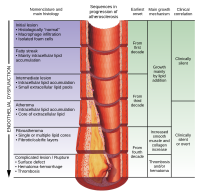
Photo from wikipedia
BACKGROUND AND AIMS Several studies have confirmed the presence of bacterial DNA in atherosclerotic plaques, but its contribution to plaque stability and vulnerability is unclear. In this study, we investigated… Click to show full abstract
BACKGROUND AND AIMS Several studies have confirmed the presence of bacterial DNA in atherosclerotic plaques, but its contribution to plaque stability and vulnerability is unclear. In this study, we investigated whether the bacterial plaque-profile differed between patients that were asymptomatic or symptomatic and whether there were local differences in the microbial composition within the plaque. METHODS Plaques were removed by endarterectomy from asymptomatic and symptomatic patients and divided into three different regions known to show different histological vulnerability: A, upstream of the maximum stenosis; B, site for maximum stenosis; C, downstream of the maximum stenosis. Bacterial DNA composition in the plaques was determined by performing 454 pyrosequencing of the 16S rRNA genes, and total bacterial load was determined by qPCR. RESULTS We confirmed the presence of bacterial DNA in the atherosclerotic plaque by qPCR analysis of the 16S rRNA gene but observed no difference (n.s.) in the amount between either asymptomatic and symptomatic patients or different plaque regions A, B and C. Unweighted UniFrac distance metric analysis revealed no distinct clustering of samples by patient group or plaque region. Operational taxonomic units (OTUs) from 5 different phyla were identified, with the majority of the OTUs belonging to Proteobacteria (48.3%) and Actinobacteria (40.2%). There was no difference between asymptomatic and symptomatic patients, or plaque regions, when analyzing the origin of DNA at phylum, family or OTU level (n.s.). CONCLUSIONS There were no major differences in bacterial DNA amount or microbial composition between plaques from asymptomatic and symptomatic patients or between different plaque regions, suggesting that other factors are more important in determining plaque vulnerability.
Journal Title: Atherosclerosis
Year Published: 2017
Link to full text (if available)
Share on Social Media: Sign Up to like & get
recommendations!